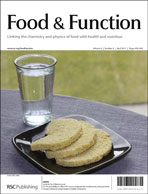Chemical and sensory characterisation of whole and fractionated myrosinase-free extracts from selected Australian-grown, raw Brassica vegetables (broccoli, cauliflower, Brussels sprouts and red cabbage) was carried out to determine the contribution of key phytochemicals (i.e. glucosinolates, free sugars, phenolics) to the taste profiles of these vegetables. Glucosinolate (GS) and phenolic profiles were determined by liquid chromatography coupled with photodiode array detection and mass spectrometry. Ten glucosinolates (GS) were quantified across the vegetables investigated. Brussels sprouts (186.3 μg g−1 FW) followed by broccoli (164.1 μg g−1 FW) were found to contain the most GS. The phenolic profiles of all samples were dominated by hydroxycinnamic acid derivatives. As expected, red cabbage was the only vegetable with a significant anthocyanin signal (574.0 μg g−1 FW). Red cabbage (26.7 mg g−1 FW) and cauliflower (18.7 mg g−1 FW) were found to contain a higher concentration of free sugars than Brussels sprouts (12.6 mg g−1 FW) and broccoli (10.2 mg g−1 FW). Descriptive sensory analysis of the whole extracts found sweetness (cauliflower and red cabbage sweeter than broccoli and Brussels sprouts) and bitterness (Brussels sprouts more bitter than others) as the most discriminating attributes. A hydrophilic fraction with sweetness, umami and saltiness as the main attributes was the most taste active fraction across all Brassica whole extracts. Sub-fractionation showed that this fraction was also bitter but the presence of sugars counteracted bitterness. Several components within each extract were found to contribute to the bitterness of whole Brassica extracts. The total and individual GS content alone could not explain the perceived bitterness of these extracts. Phenolics and/or other components are likely to be contributing to the bitterness associated with these vegetables.

You have access to this article
 Please wait while we load your content...
Something went wrong. Try again?
Please wait while we load your content...
Something went wrong. Try again?


 Please wait while we load your content...
Please wait while we load your content...